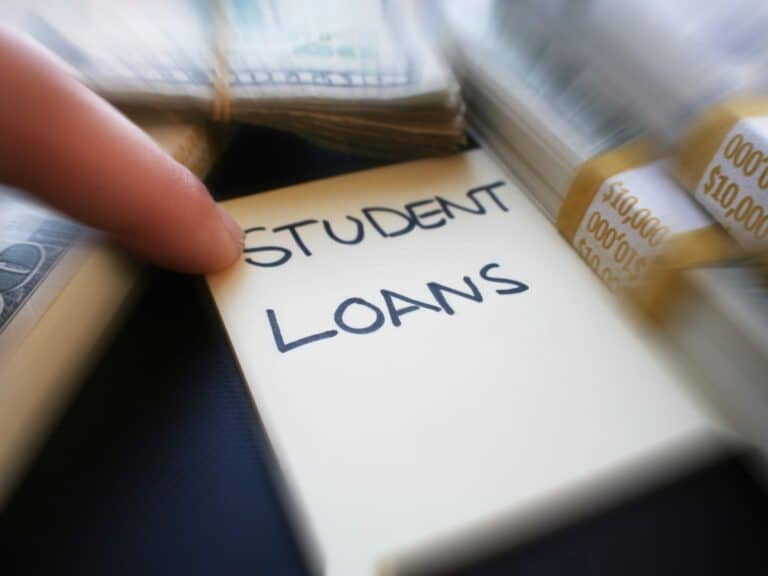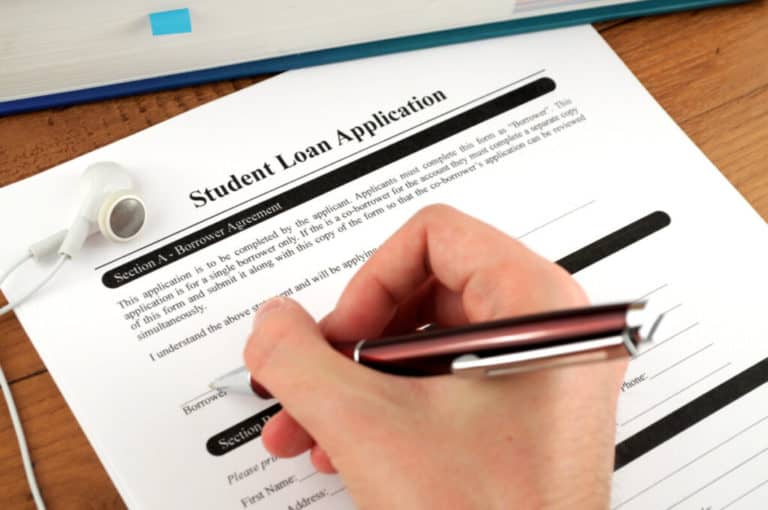Loans Explained
Student loans make paying for college easier.
However, the different types of student loans available, each one with its own set of terms and conditions, plus all the technical jargon terms — principal, interest rates, deferment, forgiveness, grace period, consolidation, etc. — can make things complicated and intimidating.
In this post, we will talk about some basic information about student loans so that you can have a much better idea if it’s the better college financing approach for you compared to your other payment options.
Student Loan Interest Rates
The student loan interest rate is the amount a lender charges a degree-seeking student. It’s a small percentage of the amount of money taken out — or loan principal, which we will discuss shortly.
It’s because of the interest that you end up paying off more loan money than you borrowed at the start.
Generally speaking, private student loans have higher interest rates than federal student loans, although it’s on a case-to-case basis — having a co-signer with a good credit score, for instance, may let you enjoy lower private loan interest rates.
For undergraduate students with federal loans, the interest rate is, as of this writing, set at 5.5%, although subsidized loans do not accrue interest while you’re still in college and enrolled at least half-time.
The interest rate for graduate students, meanwhile, ranges from 7.05% to 8.05%, depending on the federal loan.
When it comes to private student loans, interest rates are usually between 4% and 16%.
Loan Principal
Loan principal is the amount of money you borrowed to pay for college.
So, in other words, it’s the original amount that you borrowed, with complete disregard of interest and other associated fees a loaner may charge the borrower.
In some instances, you may come across what’s referred to as the principal balance.
Putting it simply, your principal balance is the amount of student debt you owe — it’s the amount of money you take out and have to repay. Needless to say, the more payments you make, the lower your principal balance gets.
Taking interest into account, of course, is important in determining your loan principal balance — the interest rate set by the federal government is fixed, while the interest rate set by a private lender can either be fixed and varying.
Before taking out a student loan, it’s important to consider the impact interest has on your loan principal.
Loan Term/Duration
Loan term or duration refers to the length of time that it takes for the student loan to be paid off completely if the borrower makes payments on a regular basis.
The term or duration of a student loan can either be short-term or long-term.
Got federal student loans? Then repayment typically starts 6 months after graduation or drops below half-time status.
The standard repayment term on a federal student loan is 10 years, although there are also options that allow you to pay off your student loan completely anywhere from 12 to 30 years.
On the other hand, the standard repayment term on a private student loan is anywhere from 5 to 15 years.
What’s nice about a long student loan term is that you pay a smaller amount per month.
However, considering the interest rate, you could end up paying a lot more than you borrowed from the federal government or a private lender.
A short student loan term, meanwhile, involves paying a huge sum of money per month alright. However, it allows you to get out of debt faster, thus allowing you to pay fewer interests.
Deferment
A student loan deferment, in a nutshell, is a predetermined period of time where the borrower won’t have to make any payments.
So, in other words, he or she won’t have to repay the principal on a loan as well as any interest.
However, it doesn’t mean that loan interest won’t build up — on some types of loan, it will.
You may have to pay interest, depending on whether your federal student loan is subsidized or unsubsidized. Interest not paid as a part of the deferment plan will be added to the overall balance.
As far as federal loans go, you might get a student loan deferment if you are:
- Enrolled in school at least half-time
- Enrolled in a rehabilitation training program
- Performing qualifying military service
- A post-active duty service member
- In a graduate fellowship program
- Experiencing economic hardship
- Unemployed
- Going through cancer treatment
- A Parent PLUS borrower with a child enrolled in college
Forbearance
A loan forbearance is like a loan deferment in that it allows the borrower to stop repaying his or her student loan for a while.
However, unlike a loan deferment, interest accumulates on all loan types during a loan forbearance.
Other than temporarily stopping debt repayment, a loan forbearance may also mean getting a lower interest rate.
There are a couple of types of loan forbearance: general and mandatory.
Which type of loan forbearance plan a borrower is eligible for depends on the circumstance/s that require him or her to consider applying for such.
Some of the things that might make you eligible for a general loan forbearance include:
- Experiencing financial difficulties
- Paying a high medical bill
- Just got a new job
On the other hand, the following might make you eligible for a mandatory loan forbearance:
- Having student loan payments that are high in relation to your income
- Serving in AmeriCorps
- Working as a teacher
- Working in a medical or dental internship or residency
Forgiveness
In a nutshell, student loan forgiveness eliminates, cancels or forgives some or all of the borrower’s federal loan debt, thus relieving him or her of the obligation to pay back money borrowed for college.
Before anything else, let’s point out that loan forgiveness applies only to federal student loans.
So, in other words, it’s not an option if your loan was taken out from a private lender — a borrower with a private student loan can enjoy something similar to loan forgiveness only through death or total and permanent disability discharge.
Here are some of the things that might get you qualified for loan forgiveness:
- If you’re a teacher
- If you work for a non-profit organization
- If you’re a government employee
- If you’re a medical professional
- If you have a disability
In some instances, your college’s action may make you qualify for loan forgiveness such as:
- If it closes
- If it misled you
Repayment Plans
Both federal student loans and private student loans come with different repayment plans. The general consensus is that federal student loans have more favorable loan repayment plans, including flexible options.
A fixed monthly payment plan is the most common loan repayment plan for both federal and private student loans.
Depending on the type of federal loan, a fixed repayment plan can either be standard or graduated, both of which are designed to check that your loans are paid off within 10 years, or extended that allows you to pay off your loans within 25 years.
There’s a loan repayment program for federal student loans that can prove to be extremely beneficial for certain people that no private student loans on the face of the planet offer: the Income-Driven Repayment (IDR) plan.
Simply put, an IDR plan adjusts your monthly payments based on your family size and monthly income.
Default on Student Loan
Defaulting on a student loan means the borrower fails to pay his or her student loans according to the terms and conditions of the loan agreement, which essentially means that the promissory note was not honored by the borrower.
When a federal loan is considered to be in default can vary.
For a loan made under the Federal Family Education Loan Program or the William D. Ford Federal Direct Loan Program, for instance, the loan is considered in default if loan payments are not made for at least 270 days.
Meanwhile, for a loan made under the Federal Perkins Loan Program, the loan may be declared on a default by the borrower if he or she fails to make the scheduled payment by the due date.
The following are just some of the possible effects of defaulting on a federal student loan:
- The remaining balance and interest becomes immediately due (also known as acceleration)
- Loss of eligibility for additional federal student aid
- Loss of eligibility for choosing a repayment plan and other benefits
- Damaged credit rating
- Inability to purchase or sell assets such as real estate
Defaulting on a private student loan, on the other hand, might result in you being taken to court by the lender or a portion of your salary being sent to the loan holder by your employer for repayment purposes.
Consolidation of Student Loans
Consolidation of student loans refers to the combination of multiple student loans into a single loan, which, of course, results in only a single payment per month. Also, interest rates become a weighted average.
Both federal student loans and private student loans can be consolidated.
The Direct Consolidation Loan allows borrowers to consolidate certain or all federal loans, thus making repaying borrowed money for college easier as well as potentially allowing them to enjoy a lower interest rate.
In the world of private student loans, consolidating loans is referred to as refinancing.
A Direct Consolidation Loan and refinancing allows you to enjoy pretty much the same perks, including extended repayment terms to keep the impact of repaying student loan on your wallet to a minimum.
Grace Period
A student loan grace period makes it possible for the borrower to delay payment for a short period of time beyond the due date.
During a grace period, the borrower cannot be penalized.
The vast majority of student loans come with a grace period of six months.
In most instances, a student loan grace period starts after you graduate from college or drop below half-time enrollment — you can start repaying your loan six months after that happens.
Disclaimer: The views and opinions expressed in this article are those of the authors and do not necessarily represent those of the College Reality Check.




